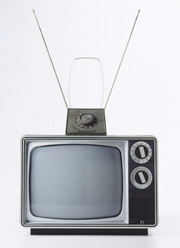Television
Television (also, informally, "TV" and "telly") is the electronic transmission of moving pictures. The word "television" literally means "far sight"; it was formed by combining the Greek word τῆλε ("tele", or "far") with the Latin word visio-n ("sight", from video, vis- to see) — this coinage follows the pattern of telegraph ("far writer") and telephone ("far talker"). A parallel constuction may be found in German, where it is known as "fernsehen" or "far-seer." In general usage, the meaning of "television" has been expanded to also refer to receivers, and to video in conventional broadcast as well as cable and satellite signals.The word is also used to describe, in broad terms, the content of television programming generally.
Emergence of television as a mass medium
Content of television programming
The content of television has evolved considerably since the earliest broadcasts in the late 1920's in Britain. The evolution of the medium can best be understood by looking at the broad historical trends, which themselves were often driven by technical innovations, such as higher definition signals, color, and an increased number of available channels and networks.
Earliest broadcasts: 1929-1935
In its earliest days, there was a good deal of incertainty as to what exactly what sort of material was suitable for broadcasts. The BBC's earliest broadcasts using the Baird system tended to focus on music-hall performers, singers, and novelty acts. A typical daily program, from the week of December 4th 1930, included the folowing:
- Bernard Dudley - character vocalist
- Pauline & Diana - instrumental entertainment
- Keith Mason - and his ukelele
- Eric Mason - entertainer and conjurer
- Gaye Jukes - musical comedy artists
- "Coal comfort" - a sketch by L. Saxey
- Jack Royce - coon songs
As the earliest regularly scheduled broadcasts of television in the world, this Baird programming is quite remarkable. Most of the acts were scheduled for only a few minutes each, as the BBC had only allocated a half-hour at morning and at night. There are, in fact, surviving home recordings of these broadcasts; using a "Silvatone" home-recording deck, a viewer in 1933 had recorded a number of snippets of the BBC signal, including a segment featuring the "Paramount Astoria Girls," a popular dance trope of the day. These recording have been restored by Scottish engineer Donald McLean, and give a unique window into early television, as they are the first recordings ever made of broadcast television.[2] It is remarkable what the producers were able to accomplish with their heavy, fixed camera and sharply limited camera angle; the full recording shows faces popping out from behind a curtain, followed by the entry of the dancing girls, over which the camera was slowly panned (the onlu motion then possible) Due to the fact that the Silvatone disc could record only one channel, there is no sound.
Social impact of television
References
- ↑ Clip of 1933 recording. Used with permission of Donald McLean from his tvdawn.com website.
- ↑ See [1] for details on "The Earliest Known Recording of Broadcast Television," by Donald McLean.
